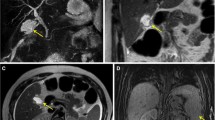Abstract
Traumatic noniatrogenic biliary injuries, unlike iatrogenic injuries, are usually complex in nature and are frequently associated with other multiorgan trauma and infection. Bile leaks following these injuries are an important source of short-and long-term morbidity. Repeat surgery for primary repair of complex bile leaks is difficult and can be complicated by anastomotic leakage and biliary stricture formation. Endoscopic retrograde cholangiopancreatography (ERCP) was initially used only as a diagnostic technique to guide surgical repair in this setting. However, with the high success rates observed in treatment of iatrogenic bile leaks, ERCP has emerged as a nonoperative treatment option for noniatrogenic biliary leaks as well. Recent data show that ERCP is effective in managing bile leaks after blunt and sharp liver injuries, using transpapillary stenting, endoscopic sphincterotomy, or both, with greater than 80% healing rates. The evidence is not clear regarding which ERCP maneuver—endoscopic sphincterotomy, transpapillary stenting, or both—should be used.
Similar content being viewed by others
References and Recommended Reading
Coughlin PA, Stringer MD, Lodge JP, et al.: Management of blunt liver trauma in a tertiary referral centre. Br J Surg 2004, 91:317–321.
Asensio JA, Demetriades D, Chahwan S, et al.: Approach to the management of complex hepatic injuries. J Trauma 2000, 48:66–69.
Feliciano DV, Mattox KL, Jordan GL Jr, et al.: Management of 1000 consecutive cases of hepatic trauma (1979–1984). Ann Surg 1986, 204:438–445.
Croce MA, Fabian TC, Menke PG, et al.: Nonoperative management of blunt hepatic trauma is the treatment of choice for hemodynamically stable patients. Results of a prospective trial. Ann Surg 1995, 221:744–753.
Rodriguez-Montes JA, Rojo E, Martin LG: Complications following repair of extrahepatic bile duct injuries after blunt abdominal trauma. World J Surg 2001, 25:1313–1316.
Sawaya DE Jr, Johnson LW, Sittig K, et al.: Iatrogenic and noniatrogenic extrahepatic biliary tract injuries: a multi-institutional review. Am Surg 2001, 67:473–477.
Lubezky N, Konikoff FM, Rosin D, et al.: Endoscopic sphincterotomy and temporary internal stenting for bile leaks following complex hepatic trauma. Br J Surg 2006, 93:78–81.
D’Amours SK, Simons RK, Scudamore CH, et al.: Major intrahepatic bile duct injuries detected after laparotomy: selective nonoperative management. J Trauma 2001, 50:480–484.
Sherlock DJ, Bismuth H: Secondary surgery for liver trauma. Br J Surg 1991, 78:1313–1317.
Bajaj JS, Spinelli KS, Dua KS: Postoperative management of noniatrogenic traumatic bile duct injuries: role of endoscopic retrograde cholangiopancreaticography. Surg Endosc 2006, 20:974–977.
Laborde Y, Strainchamps P, Kermele H,, et al.: [Role of biliary MRI in the diagnosis and management of bile peritonitis due to closed trauma of the liver]. J Chir (Paris) 2006, 143:125–127.
Carrillo EH, Spain DA, Wohltmann CD, et al.: Interventional techniques are useful adjuncts in nonoperative management of hepatic injuries. J Trauma 1999, 46:619–622.
Sugiyama M, Atomi Y, Matsuoka T, et al.: Endoscopic biliary stenting for treatment of persistent biliary fistula after blunt hepatic injury. Gastrointest Endosc 2000, 51:42–44.
Youngelman DF, Marks JM, Ponsky T, et al.: Comparison of bile duct pressures following sphincterotomy and endobiliary stenting in a canine model. Surg Endosc 1997, 11:126–128.
Geenen JE, Toouli J, Hogan WJ, et al.: Endoscopic sphincterotomy: follow-up evaluation of effects on the sphincter of Oddi. Gastroenterology 1984, 87:754–758.
Sandha GS, Bourke MJ, Haber GB, et al.: Endoscopic therapy for bile leak based on a new classification: results in 207 patients. Gastrointest Endosc 2004, 60:567–574.
Griffen M, Ochoa J, Boulanger BR: A minimally invasive approach to bile peritonitis after blunt liver injury. Am Surg 2000, 66:309–312.
O’Rourke EJ, Thakar C, Tibballs J, et al.: Complex injuries from a gunshot injury to the upper abdomen. Have we moved to the post surgery era? Clin Radiol 2005, 60:930–934.
Kozar RA, Moore FA, Cothren CC, et al.: Risk factors for hepatic morbidity following nonoperative management: multicenter study. Arch Surg 2006, 141:451–458.
Christmas AB, Wilson AK, Manning B, et al.: Selective management of blunt hepatic injuries including nonoperative management is a safe and effective strategy. Surgery 2005, 138:606–610.
Author information
Authors and Affiliations
Corresponding author
Rights and permissions
About this article
Cite this article
Bajaj, J.S., Dua, K.S. The role of endoscopy in noniatrogenic injuries of the liver. Curr Gastroenterol Rep 9, 147–150 (2007). https://doi.org/10.1007/s11894-007-0009-0
Published:
Issue Date:
DOI: https://doi.org/10.1007/s11894-007-0009-0




